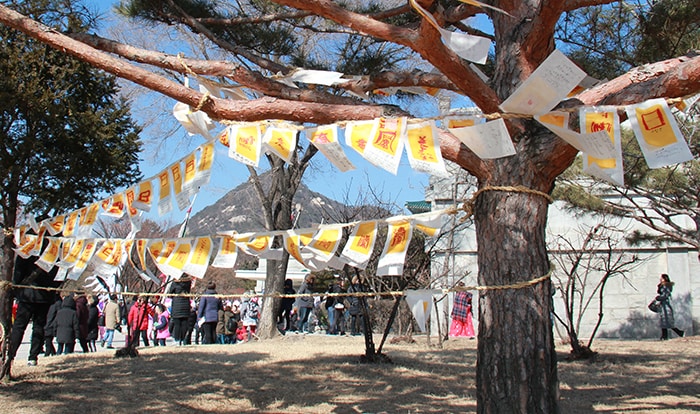
On the day of Jeongwol Daeboreum (정월대보름), the first full moon of the lunar new year, a jubilant child receives a packet of bureom, an assortment of nuts, at the National Folk Museum on Feb. 11.
“May your ears be sharp and your eyes clear!”
On the day of Jeongwol Daeboreum (정월대보름), the first full moon of the lunar new year, it was easy to overhear parents uttering these words to their young children while giving them a pat on their little heads.
The families were at the National Folk Museum of Korea on Feb. 11 where a festival was held to celebrate the rising of the first full moon. People young and old lined up to receive packets of bureom (부럼) — an assortment of walnuts, pine nuts and peanuts — that symbolizes good health for the year ahead. It’s believed that eating a handful of these nuts protects young children from even the most minor of rashes.
While parents explained the meaning behind these customary snacks, they dabbed some gwibalgisul (귀밝이술), or ear-sharpening rice wine, on the lips of their little ones. This was because a shot of chilled rice wine is supposed to sharpen one’s hearing and bring only pleasant news to one’s ears all year long.

A rendition of the Iksan gisebae nori (익산 기세배 놀이), a folk tradition originating in Iksan, Jeollabuk-do Province, is performed at the National Folk Museum on Feb. 11 in celebration of Jeongwol Daeboreum (정월대보름), the first full moon of the lunar new year.
In addition to the auspicious snacks, the National Folk Museum came alive with various folk games associated with the Daeboreum holiday. Visitors could try their hand at jwibulnori (쥐불놀이), swinging burning coals around in a tin can, or carve sotdae (솟대), wooden poles serving as good luck charms. They could also write down their wishes on a lucky amulet and tie it to a tree in the museum’s front yard.
Visitors were also treated to a performance of the Iksan gisebae nori (익산 기세배 놀이), a folk tradition originating in Iksan, Jeollabuk-do Province, that greets the new year with a wave of tall flags. Accompanied by a chorus of rhythmic instruments, the group of dancers portraying traditional farmers carried out a shamanistic ritual, wishing for the town’s peace and prosperity. Impressed by this display of one of the most pastoral of Korean rituals one can see on the day of the full moon, the audience eagerly snapped pictures of the proceedings.
Meanwhile, elsewhere on museum grounds, artisans were busy at work piling sheaves of rice in the shape of a cone, known as the byeotgaritdae (볏가릿대), a tradition carried out by farmers in hopes for a year of plenty. Children circled the men, watching them as they wrapped grains like rice, beans, millet and sorghum in straw and cloth. The young kids even joined in the activity, twisting the sheaves into thin ropes while observing the artisans from over their shoulders. When the column of straw cones was finally raised to its full height, all heads were tilted high to the blue sky.

A neat row of cloth amulets containing wishes written down by visitors hangs from the boughs of pine trees at the National Folk Museum on Feb. 11, the day of the first full moon of the lunar new year.
The festivities for the Daeboreum holiday took place in other parts of Seoul, too.
At Seoul’s Bukchon Cultural Center, a traditional gugak singing concert took place against the backdrop of a Hanok residence. Despite the frosty weather, visitors sat on straw mats laid out in the courtyard and cheered the musicians who brought song and dance to the stage, wishing for a plentiful year ahead.
By Lee Hana
Korea.net Staff Writer
Photos: Lee Hana
hlee10@korea.kr

In celebration of Jeongwol Daeboreum (정월대보름), the first full moon of the lunar new year, a column made of straw cones, called a byeotgaritdae (볏가릿대), is hoisted up at the National Folk Museum on Feb. 11.

Skilled artisans tie together straw cones to form a column for the byeotgaritdae (볏가릿대), a tradition carried out by farmers in hopes for a year of plenty, on the day of the full moon at the National Folk Museum on Feb. 11.

An audience enjoys a performance of the Chunengmu (춘앵부) at the Bukchon Cultural Center, held in celebration of Jeongwol Daeboreum (정월대보름), the first full moon of the lunar new year.























